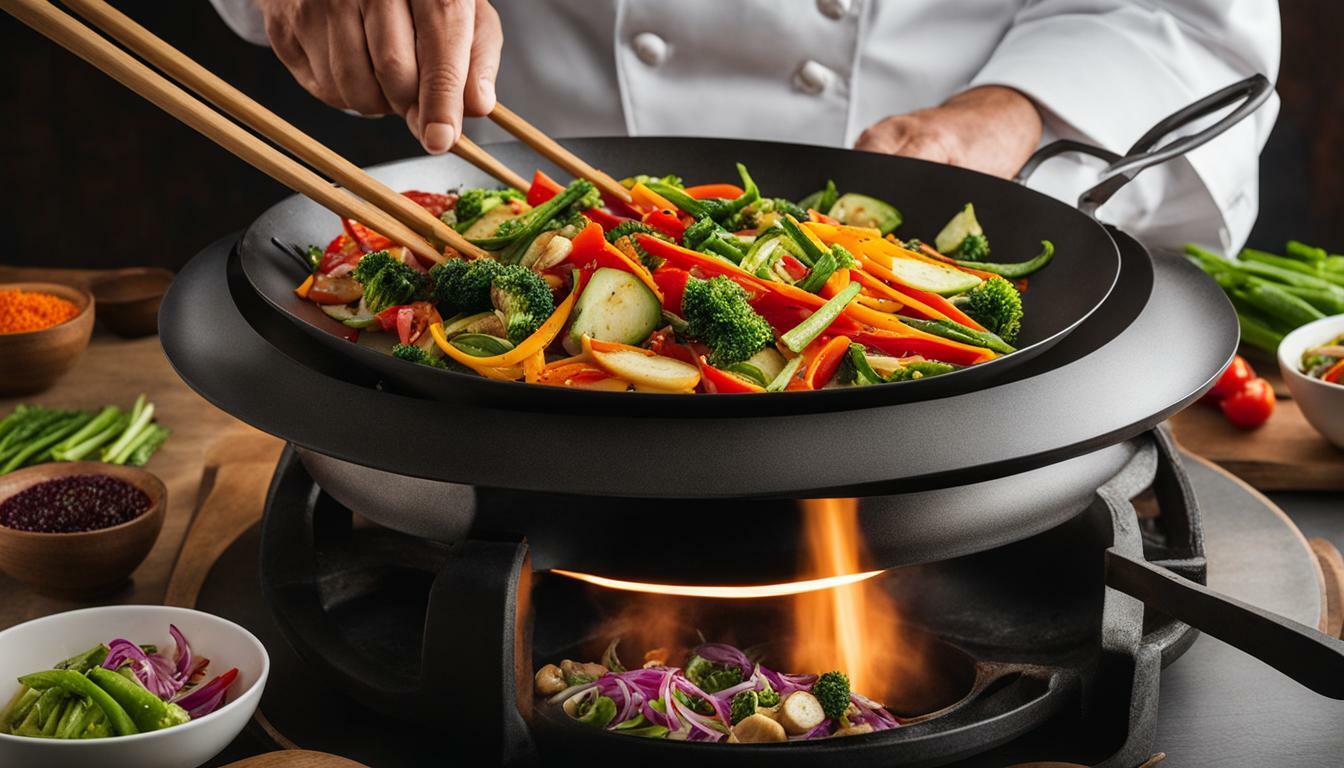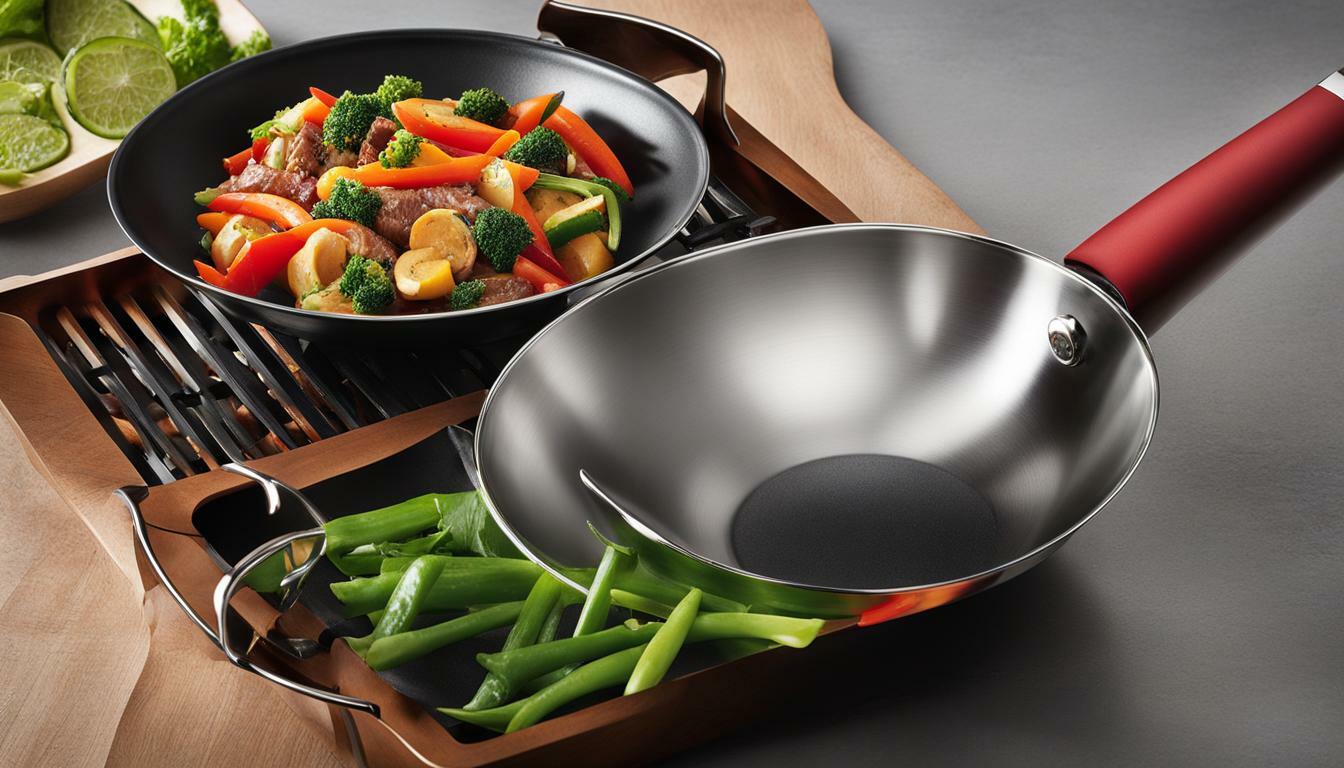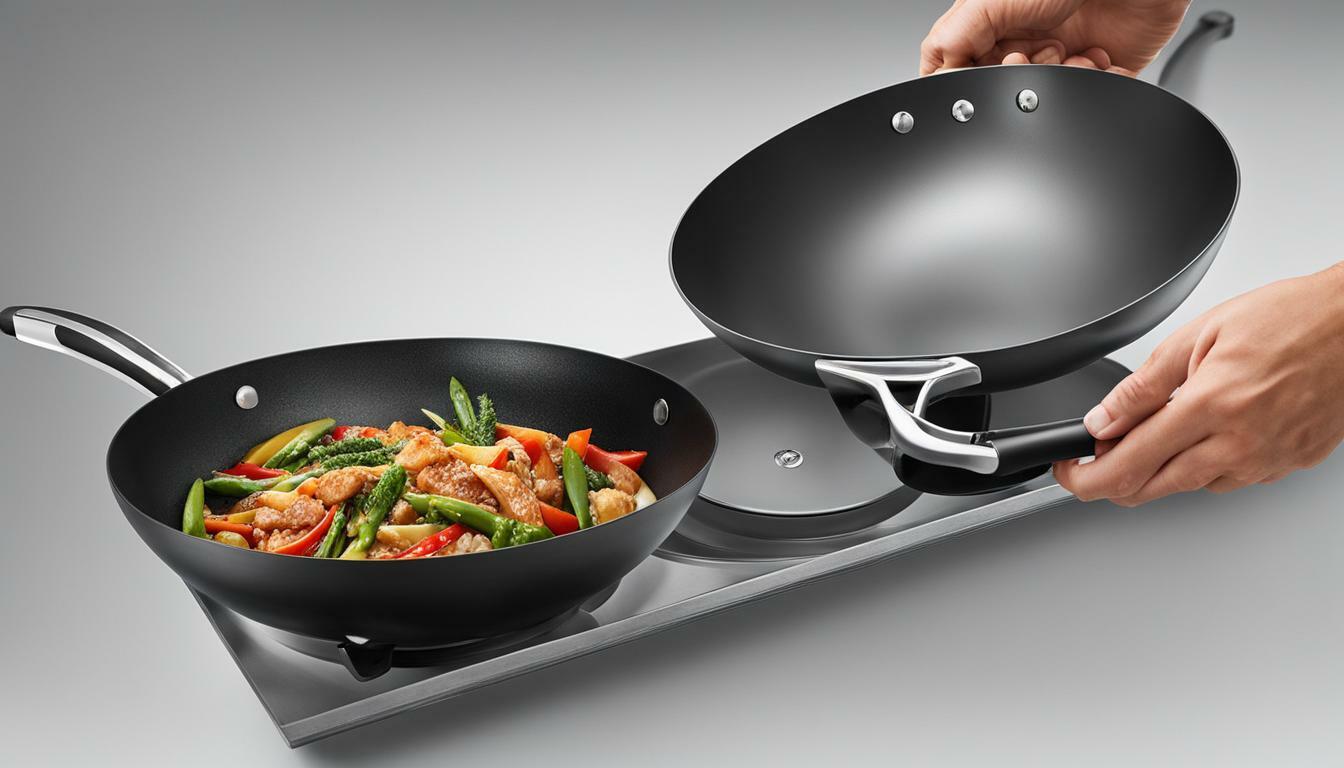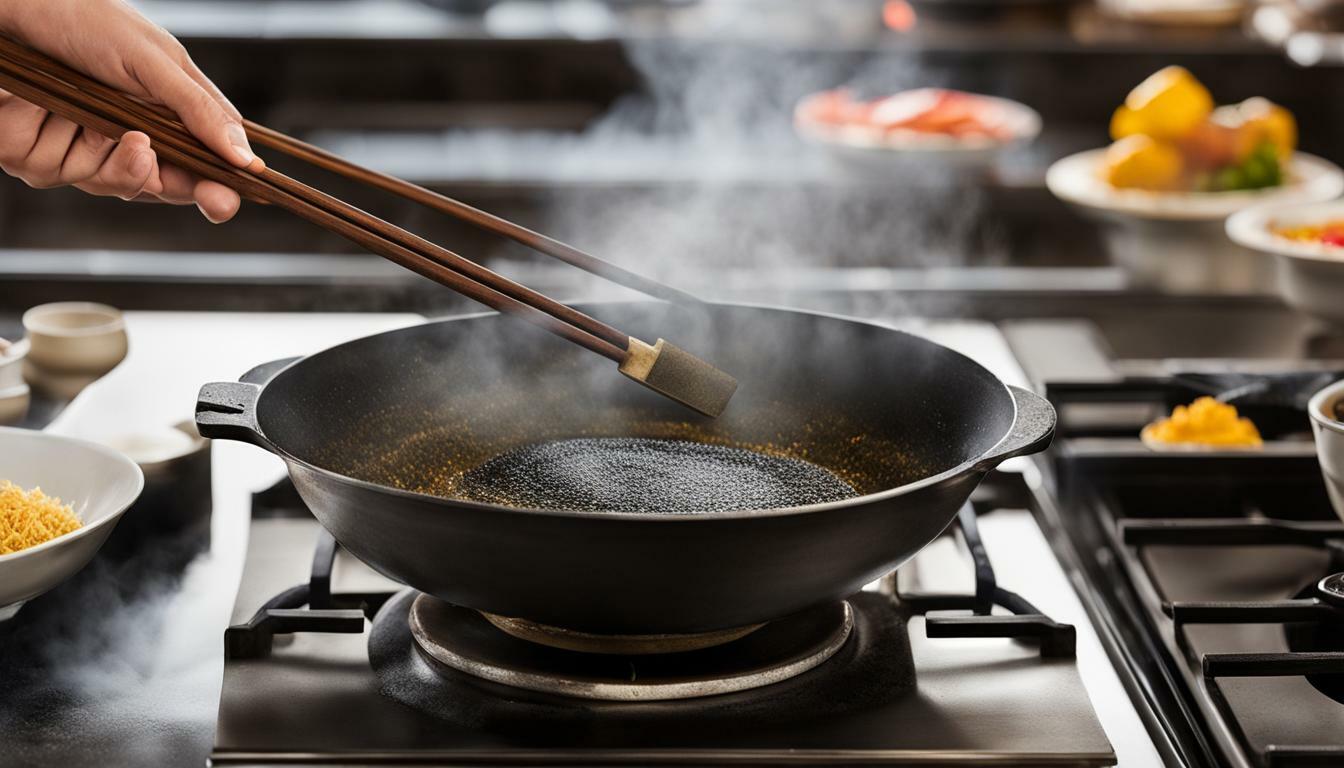When it comes to the ultimate kitchen companion, the debate of wok vs frying pan takes center stage. While both are crafted from durable carbon steel, their distinct shapes offer unique advantages in the culinary realm.
Table of Contents
Toggle- Woks and frying pans are both made from carbon steel but differ in shape.
- A wok has a rounded bottom and sloping walls, ideal for quick and even cooking.
- A frying pan has a flat bottom and flared sides, perfect for searing and sautéing.
- The choice between a wok and a frying pan depends on the specific dishes and cooking techniques desired.
- Consider your personal preferences and cooking needs to find the perfect cooking companion.
The Shape and Design Comparison
The key disparity between a wok and a frying pan lies in their shape and design, with a wok featuring a rounded bottom and sloping walls, while a frying pan boasts a flat bottom and flared sides. These differences significantly impact the cooking experience and determine the versatility of each cookware.
A wok’s rounded bottom and sloping walls make it the perfect tool for stir-frying. The unique shape allows for quick and even heat distribution, ensuring that your ingredients are cooked to perfection. Whether you’re whipping up a stir-fry feast or searing meat, the wok’s design promotes effortless tossing and flipping, preventing your food from sticking to the surface.
On the other hand, a frying pan’s flat bottom and flared sides make it an excellent choice for various cooking techniques. From searing steaks to sautéing vegetables, the flat surface provides maximum contact with the heat source, resulting in a crispy and evenly browned exterior. The flared sides allow for easy flipping and tossing, making it ideal for dishes that require frequent stirring.

Understanding the differences in shape and design between a wok and a frying pan is crucial in selecting the right cookware for your culinary adventures. Whether you’re a stir-fry enthusiast or prefer versatile cooking options, knowing how each cookware can enhance your dishes will elevate your cooking skills to new heights.
| Wok: The Stir-Frying Maestro | Frying Pan: The Versatile Sidekick |
|---|---|
| Benefits | Benefits |
| Quick and even cooking | Searing and sautéing |
| Retains heat well | Shallow frying |
| Ideal for stir-frying | Quick heating |
| Can be used for deep frying and steaming | Excellent heat retention |
Ultimately, the choice between a wok and a frying pan comes down to your personal preferences and the specific dishes and cooking techniques you enjoy. So, whether you go for the stir-frying maestro or the versatile sidekick, both the wok and frying pan will serve as reliable companions in your culinary adventures.
Wok: The Stir-Frying Maestro
The wok, with its distinctive shape, reigns supreme when it comes to stir-frying, thanks to its ability to provide quick and even cooking. The rounded bottom and sloping walls of a wok ensure that heat is distributed evenly, allowing ingredients to cook rapidly without burning. This makes it the perfect cooking companion for anyone looking to whip up a delicious stir-fry in no time.
But the benefits of a wok extend beyond stir-frying. Its design also allows for excellent heat retention, making it ideal for deep frying and steaming. The high sides of the wok prevent oil from splattering, while the rounded bottom ensures that ingredients are evenly coated in hot oil for perfectly crispy results. Additionally, the wide shape of the wok provides ample space for steaming vegetables or dumplings, allowing them to cook gently and retain their natural flavors.
Stir-frying, deep frying, and steaming are just a few of the cooking techniques that a wok excels at. Its versatility and efficient heat distribution make it a must-have in any kitchen. Whether you’re whipping up a quick weeknight meal or experimenting with complex flavors, the wok will always be there to deliver exceptional results.

| Benefits of a Wok |
|---|
| Quick and even cooking |
| Stir-frying |
| Heat retention |
| Deep frying |
| Steaming |
Testimonial
I’ve been using a wok for stir-frying for years, and I can’t imagine my kitchen without it. The even heat distribution and quick cooking time make it effortless to create delicious and healthy meals. From savory stir-fries to crispy tempura, the wok has never let me down.
- Stir-frying: Quick and even cooking.
- Deep frying: Retains heat for perfect crispiness.
- Steaming: Allows gentle and flavorful cooking.
Frying Pan: The Versatile Sidekick
As a reliable kitchen sidekick, the frying pan showcases its versatility through its capacity for searing, sautéing, and shallow frying, all made possible by its quick heating and exemplary heat retention.
When it comes to searing, a frying pan excels at providing high heat, allowing you to achieve that perfect golden crust on meats, fish, or even vegetables. The flat bottom ensures even heat distribution, while the flared sides make it easy to flip and maneuver ingredients with precision.
In addition to searing, a frying pan is also a master of sautéing. The wide, flat surface area allows for quick and even cooking, making it ideal for tossing and stirring ingredients. Whether you’re sautéing vegetables, browning garlic, or creating a flavorful stir-fry, the frying pan is your go-to tool.
For those who enjoy shallow frying, the frying pan delivers exceptional results. The quick heating properties allow you to achieve a crispy exterior while maintaining a moist interior. From crispy chicken cutlets to perfectly fried eggs, the frying pan’s versatility shines through in this cooking technique.

A frying pan is not just a tool; it’s an essential companion in the kitchen. Here are a few additional benefits to consider:
- Quick heating: The frying pan heats up rapidly, reducing cooking time and allowing for efficient meal preparation.
- Heat retention: The frying pan’s ability to retain heat ensures that your food stays warm even after it’s removed from the heat source.
Whether you’re searing a steak, sautéing vegetables, or shallow frying your favorite delicacies, the frying pan’s versatility knows no bounds. It’s a reliable and adaptable kitchen companion that will elevate your culinary creations to new heights.
Table:
| Frying Pan Benefits |
|---|
| Capacity for searing |
| Versatility in sautéing |
| Excellence in shallow frying |
| Quick heating |
| Superb heat retention |
Choosing the Perfect Companion
The choice between a wok and a frying pan ultimately depends on the specific dishes and cooking techniques you have in mind. Both cookware options offer unique benefits and excel in different areas, making them suitable for various culinary adventures. To make an informed decision, consider the following factors:
- Specific Dishes: Think about the types of dishes you frequently prepare or want to explore. If you enjoy stir-frying, deep frying, or steaming, a wok is undoubtedly your go-to companion. Its shape encourages quick and even cooking, allowing you to achieve that perfect stir-fry texture and flavor. On the other hand, if you often sear, sauté, or shallow fry, a frying pan’s versatility and flat bottom will provide excellent results.
- Cooking Techniques: Take into account the cooking techniques you prefer or want to experiment with. A wok’s high, sloping walls and round bottom make it ideal for tossing ingredients and creating beautiful stir-fry dishes. Additionally, its excellent heat retention is perfect for deep frying or steaming. Conversely, a frying pan’s flat bottom and flared sides are excellent for searing and sautéing. The frying pan also heats up quickly, making it convenient for various cooking methods.
By considering your desired dishes and preferred cooking techniques, you can confidently choose the perfect cooking companion. Experimenting with both a wok and a frying pan allows you to expand your culinary repertoire and adapt to different recipes and flavors. Remember, there’s no right or wrong choice—ultimately, it’s about finding the cookware that resonates with your cooking style and brings you joy in the kitchen.
Table: Comparing Wok and Frying Pan
| Wok | Frying Pan | |
|---|---|---|
| Shape | Rounded bottom, sloping walls | Flat bottom, flared sides |
| Primary Use | Stir-frying, quick cooking, deep frying, steaming | Searing, sautéing, shallow frying |
| Heat Retention | Excellent | Good |
| Versatility | Can be used for various cooking methods | Can be used for various cooking methods |
Keep in mind that having both a wok and a frying pan in your kitchen arsenal can open up a world of culinary possibilities. While each has its specialties, they complement one another and allow you to tackle a wide range of recipes with confidence. So go ahead, explore the unique attributes of both wok and frying pan, and elevate your cooking experience.

Let’s delve into the specialties of each cookware, exploring the mouthwatering possibilities they offer through a variety of delectable recipes. Whether you have a wok or a frying pan, these versatile kitchen companions can create dishes that will tantalize your taste buds and impress your dinner guests.
Wok Specialties:
A wok’s unique shape and design make it perfect for stir-frying, and this cooking technique is where it truly shines. Make a sizzling stir-fry loaded with vibrant vegetables, tender meats, and aromatic spices. The high heat and spaciousness of a wok allow for quick and even cooking, ensuring that your ingredients retain their natural flavors and textures. Try an authentic Kung Pao Chicken or a zesty Pad Thai, and experience the magic of stir-frying with a wok.
Fried Rice Recipe
| Ingredients | Instructions |
|---|---|
|
|
Frying Pan Specialties:
A frying pan’s versatility makes it the perfect sidekick in the kitchen. Use it to sear a succulent steak, sauté a medley of fresh vegetables, or shallow fry crispy and golden delights. The flat bottom and flared sides of a frying pan allow for even heat distribution, resulting in perfectly cooked dishes. Try a classic Chicken piccata or a hearty Vegetable stir-fry, and savor the delicious flavors that can be achieved with a frying pan.
Pan-seared Salmon Recipe
| Ingredients | Instructions |
|---|---|
|
|
With these delightful recipes, you can showcase the specialties of both the wok and the frying pan. Experiment with different flavors, ingredients, and cooking techniques to create culinary masterpieces that will leave everyone craving for more. Whether you’re a stir-fry enthusiast or a lover of pan-seared perfection, your cooking companion awaits!

Elevate your culinary skills with some handy tips and tricks that will transform your wok or frying pan into a true cooking powerhouse. Whether you’re a seasoned chef or an amateur cook, these techniques will help you make the most out of your cookware and create delicious meals every time.
Cooking Hacks
1. Heat control: When using a wok, it’s all about high heat. Preheat your wok before adding any ingredients, and make sure it’s hot enough to create a sizzling sound when food touches the surface. For a frying pan, start with medium heat and adjust as needed. This will prevent your food from sticking and ensure even cooking.
2. Seasoning your wok: To enhance the non-stick properties of your wok, season it before the first use. Heat the wok over high heat and add a thin layer of oil. Swirl the oil around, covering the entire surface, and let it heat until smoking. Remove from heat, let it cool, and wipe away any excess oil. Your wok is now ready to use!
3. Searing perfection: For a perfect sear on meats or vegetables, make sure they are dry before adding them to the pan. Excess moisture will cause steaming instead of browning. Also, avoid overcrowding the pan, as it will lower the temperature and prevent proper searing.
Creative Recipes
Looking for some culinary inspiration? Try these recipe ideas that showcase the specialties of both the wok and frying pan:
| Wok Specialties | Frying Pan Specialties |
|---|---|
| Stir-Fried Noodles with Vegetables | Pan-Seared Salmon with Lemon Butter Sauce |
| Beef and Broccoli Stir-Fry | Chicken Piccata with Capers |
| Kung Pao Shrimp | Sautéed Mushrooms with Garlic and Thyme |
Cleaning and Maintenance
To ensure the longevity of your cookware, follow these cleaning tips and care instructions:
- For both the wok and frying pan, avoid using harsh abrasives or metal utensils that can scratch the surface.
- After cooking, let your cookware cool down before cleaning. Rinse with warm water and use a sponge or soft cloth to gently remove any food residue.
- If stubborn stains persist, create a paste of baking soda and water and gently scrub the affected areas.
- For the wok, dry it thoroughly and rub a thin layer of oil on the surface before storing to prevent rust.
- For the frying pan, apply a thin layer of oil after each use to maintain its non-stick properties.
Remember, mastering the art of cooking is a journey. With these tips and tricks, your wok or frying pan will become your trusty companion in the kitchen, helping you create unforgettable meals with ease. So go ahead, unleash your culinary creativity and enjoy the delicious flavors you can achieve with the right cookware.

Ensure the longevity of your cookware investment by following these essential maintenance and care practices for your trusty wok or frying pan. Proper care not only extends the lifespan of your cookware but also enhances its performance, allowing you to enjoy delicious meals for years to come.
Cleaning Tips
After each use, clean your wok or frying pan with warm water and a mild dishwashing detergent. Avoid using harsh abrasives or metal scouring pads, as they can damage the surface. Instead, use a soft sponge or cloth to gently scrub away any residue. For stubborn stains or food particles, soak the cookware in warm, soapy water for a few minutes before cleaning.
It’s important to note that carbon steel cookware requires special attention. To prevent rust, thoroughly dry your wok or frying pan after cleaning. You can achieve this by placing it on a low heat burner for a few minutes to evaporate any remaining moisture. Once dry, apply a thin layer of oil to the entire surface to protect it from oxidation. This process, known as seasoning, also improves the non-stick properties of the cookware over time.
Care Instructions
To maintain the quality of your wok or frying pan, avoid exposing it to extreme temperature changes. Rapid heating or cooling can cause warping, which may affect its performance. Allow the cookware to cool down naturally before washing or storing it.
When storing your cookware, stack it carefully to prevent scratches and dents. If you’re short on space, consider using soft cloth or paper towels as dividers between the pieces. This will help maintain their pristine condition.
| Cleaning Tips | Care Instructions |
|---|---|
|
|

By incorporating these maintenance and care practices into your cooking routine, you can ensure that your wok or frying pan remains in excellent condition. Remember, a well-maintained cookware not only enhances your culinary results but also adds joy to your cooking experience.
Conclusion: Finding Your Perfect Cooking Companion
In the battle of wok vs frying pan, both have demonstrated their prowess in the kitchen, leaving the choice of a cooking companion to personal preferences and desired culinary adventures. Woks, with their rounded bottoms and sloping walls, excel in stir-frying, offering quick and even cooking. Their exceptional heat retention also makes them versatile for deep frying and steaming. On the other hand, frying pans with their flat bottoms and flared sides are perfect for searing, sautéing, and shallow frying. They heat up quickly and retain heat effectively.
Deciding between a wok and a frying pan ultimately boils down to the specific dishes and cooking techniques you favor. If you’re a fan of Asian cuisine and enjoy the art of stir-frying, a wok is an excellent choice. Its shape and design allow for the perfect execution of this cooking technique, ensuring authentic flavors and textures. However, if you prefer a more versatile and multi-purpose option, a frying pan provides the flexibility to experiment with various cooking methods, from searing that perfect steak to sautéing vegetables.
Regardless of your choice, it’s crucial to consider your own preferences and cooking needs. The right cooking companion should complement your culinary aspirations and inspire you to create delicious meals. So whether you’re a wok enthusiast or a frying pan aficionado, embrace your chosen cookware, explore its specialties, and unlock the full potential it offers. Happy cooking!









